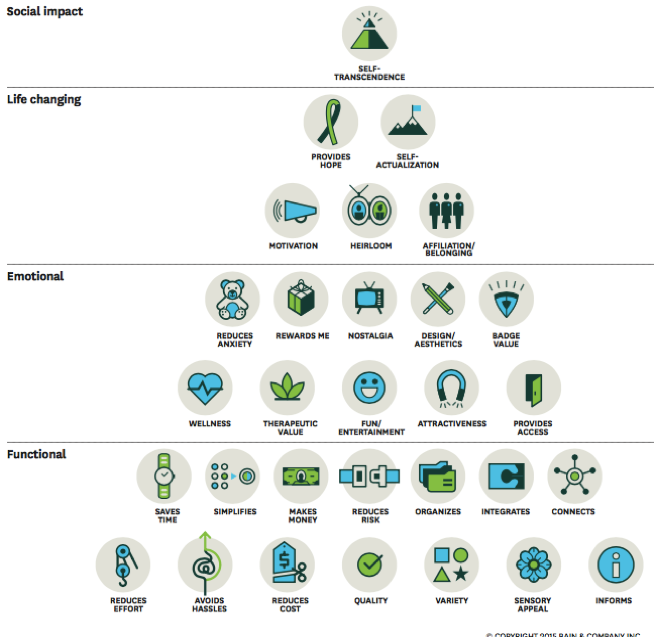The Intangible Balance Scorecard
23 March 2018Since Robert Kaplan and David Norton’s hugely successful Balance Scorecard approach to strategic business management, first published in the Harvard Business Review in 1992, organizations have sought to measure a variety of different aspects of performance. While there are many different elements of a business to measure, ‘Quality, Cost and Delivery’ has always been a fantastic way to give an overall picture of the products and services that a company provides. Together, these components go some way to encapsulate value. Customers care about all these elements and consequently, organizations do too.
These metrics are very much grounded in the physical, though. As more and more of our work moves into the intangible, digital world, is there a need for a new digital Balance Scorecard?
In Eric Almquist, John Senior and Nicolas Bloch’s September 2016 Harvard Business Review article The Elements of Value, they argue that such dimensions appear merely within the ‘functional’ realm and that much of what we value is tied up in harder-to-define emotional, life-changing and socially impactful ways.

Almquist, Senior and Bloch, 2016
They cite Amazon Prime as an innovation, which in 2005 sought merely to deliver reduced costs and saved time by providing unlimited two-day postage services for an annual fee. As the product evolved though, it expanded to include streaming services and unlimited photo storage on Amazon servers, which all help users to feel they are part of an exclusive club, packed full of multiple benefits.
At a recent conference discussing the ‘Future of Services’, Rory Sutherland explained how David Rock’s ‘SCARF’ model, which seeks to describe the different social concerns that drive human behaviour and motivate people, is a great way to explore digital services.
- Status – our relative importance to others.
- Certainty – our ability to predict the future.
- Autonomy – our sense of control over events.
- Relatedness – how safe we feel with others.
- Fairness – how fair we perceive the exchanges between people to be.
He discussed how Uber’s app appealed to customers on many of these levels. By enabling the customer to know about the driver they were about to engage – providing a name and picture, for example – the firm helped allay any fears the customer might have (sense of safety with others). They could track their driver on a map, turning ordering a taxi into more of a controllable act (sense of control over life, sense of what the future holds). The fact that no money changes hands also appeals to notions of ‘status’ and ‘fairness’. We can see that this digital example appeals to all five of the above SCARF aspects proposed by Rock.
It’s clear that these dimensions are very important, yet in nature they are very hard to quantify. Perhaps that’s why often some of the best digital leaders have an intuition and feel for the development of services that solve customers’ problems? I’d doubt that it’s as simple as that though, and when musing on the intangible alchemy of value, it’s worth discussing another elusive art – leadership.
There can be no doubt that in this ever-connected age, ‘Collaborative Leadership’ is critically important. It is built on the premise that ‘the sum of the whole is greater than the sum of its parts’, and that through inspiring cooperation, across functional boundaries between key organizational players, great things can be achieved.
Trust is paramount. Within a collaborative leadership space, personal crusades and preconceived notions of expertise should be left at the door, ideas should be shared and discussed, and real and honest feedback provided, all of which requires immense amounts of trust. Trust from the leaders that this process is worthwhile and trust from the teams that their voice will be heard meaningfully and fairly.
It seems to me that there are two key dimensions to building this trust: visibility and experimentation. In other words, does it look like they are being open and honest with me and are these observations proving to be correct?
So far, I’ve discussed that much of what comprises value can be seen to be ‘intangible’, trust to a feeling rather than a physical force, and yet I believe that the digital world, with its digital footprints and huge appetite for data, can really help to positively build trust. Sharing data across value streams can be hugely advantageous to all parties engaged in the work – for example, electronic point of sale data from a store is shared with suppliers to help them produce what’s required. Open-source software enables huge amounts of innovation to occur. Usage data, through ‘fail fast’ experimentation loops, also provides the visibility required for successful experimentation.
It’s here where I think that digitization can help to explore all of the mysterious ‘elements of value’. Through quick learning loops, achieved from limited releases and intensive customer monitoring, the business can quickly better understand the value of the services it offers through iterative feedback. So, while a great deal of alchemy is required to fully explore the value an organization provides, sharing data helps to build trust, cooperation and, most importantly, helps leaders to determine whether everything is moving in the right direction.
Comments
- Marketing Magic
- What’s My Job Again?
- The Reports Have Gone to Her Head
- Cross Stitch Standards and Creativity
- Hefin David and the Aeroplane Arms
- Hankering for a Handbook
- Window of Light
- Defensive Organising
- McMullin’s Tandem of Co-Production
- The Joy of John Parry-Jones
- The Perils of Disappointment
- The Shield of Shame
- Customer Care and Organisation Innovation
- Hooray for Humanity!
- Angry Lemons
- Double Meanings
- Ticketing Masterplans
- When will it all end …
- Lifetime Loyalty and Taylor Swift
- Looking at Things Differently
- Networking Noodles
- Addicted to Truth
- Designs on Service Design
- The Multiple Joys of Universal Design
- Hungry Cultures
- Event Lean
- The Traffic Analogy
- Moving on Up
- Rosé Cava Revolution?
- Powerpoint Sneaky Lean
- Writing about Writing
- ChatGPT Response: Exploring the Art of Expression: Unveiling the Magic of Writing in the Style of Sarah Lethbridge
- Help to Grow Coldplay Style
- Caring IS Everything!
- Institutional Flapping
- “Just Do the Next Right Thing”
- Trust Thermoclines
- Organisational Tempo
- The Inaugural Lethbridge Customer Service Awards
- Vaccine Lean – The Dawn of the Water Spider
- November 2025 (1)
- October 2025 (2)
- September 2025 (1)
- August 2025 (2)
- July 2025 (1)
- June 2025 (1)
- April 2025 (1)
- March 2025 (2)
- February 2025 (1)
- January 2025 (1)
- December 2024 (1)
- November 2024 (1)
- October 2024 (1)
- September 2024 (1)
- July 2024 (2)
- June 2024 (1)
- May 2024 (1)
- March 2024 (1)
- February 2024 (2)
- December 2023 (2)
- October 2023 (2)
- September 2023 (1)
- July 2023 (3)
- June 2023 (1)
- May 2023 (1)
- April 2023 (1)
- March 2023 (1)
- February 2023 (1)
- January 2023 (1)
- November 2022 (1)
- October 2022 (2)
- August 2022 (2)
- July 2022 (1)
- May 2022 (2)
- April 2022 (1)
- February 2022 (1)
- January 2022 (1)
- December 2021 (2)
- November 2021 (1)
- October 2021 (1)
- September 2021 (1)
- August 2021 (1)
- July 2021 (1)
- May 2021 (2)
- April 2021 (1)
- March 2021 (1)
- January 2021 (1)
- December 2020 (1)
- October 2020 (3)
- August 2020 (1)
- June 2020 (2)
- April 2020 (1)
- March 2020 (1)
- February 2020 (1)
- December 2019 (2)
- October 2019 (1)
- September 2019 (1)
- August 2019 (1)
- July 2019 (1)
- June 2019 (1)
- February 2019 (3)
- October 2018 (1)
- September 2018 (1)
- March 2018 (10)
- April 2016 (1)
- January 2015 (3)
- July 2014 (9)
- September 2013 (1)

1 comment
Comments are closed.